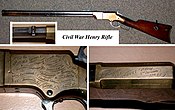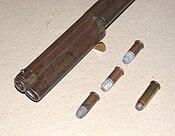| Henry Rifle | |
|---|---|
 patent drawing of the Henry rifle | |
| Type | Lever-action rifle |
| Place of origin | United States |
| Service history | |
| Used by |
|
| Wars | American Civil War, Indian Wars |
| Production history | |
| Designer | Benjamin Tyler Henry |
| Designed | 1860 |
| Manufacturer | New Haven Arms Company |
| Unit cost | $14,000 as of 2014[update] |
| Produced | 1850s to 1866 |
| No. built | 14,000 approx. |
| Specifications | |
| Mass | 9 lb 4 oz |
| Length | 44 3/4" |
| Barrel length | 29" |
|
| |
| Caliber | .44 Henry rimfire |
| Action | breech-loading lever action |
| Rate of fire | 28 rounds per min. |
| Feed system | 16 round tube magazine |
The Henry repeating rifle was a lever-action, breech-loading, tubular magazine rifle.
History[]
The original Henry rifle was a .44 caliber rimfire, lever-action, breech-loading rifle designed by Benjamin Tyler Henry in 1860. The Henry was an improved version of the earlier Volcanic Repeating rifle. The Henry used copper (later brass) rimfire cartridges with a 216 grain (14 g) bullet over 25 grains (1.6 g) of gunpowder. Nine hundred were manufactured between summer and October 1862; by 1864, production had peaked at 290 per month. By the time production ended in 1866, approximately 14,000 units had been manufactured.
For a Civil War soldier, owning a Henry rifle was a point of pride. Although it was never officially adopted for service by the Union Army, many soldiers purchased Henrys with their own funds. The brass framed rifles could fire at a rate of 28 rounds per minute when used correctly, so soldiers who saved their pay to buy one often believed it would help them survive. They were frequently used by scouts, skirmishers, flank guards, and raiding parties, rather than in regular infantry formations. To the amazed muzzleloader-armed Confederates who had to face this deadly "sixteen shooter", it was called "that damned Yankee rifle that they load on Sunday and shoot all week!"[1] Those few Confederate troops who came into possession of captured Henry rifles had little way to resupply the special ammunition used by the weapon, making its widespread use by Confederate forces impractical. The rifle was, however, known to have been used at least in part by some fifteen different Confederate units. These units included cavalry units in Louisiana, Texas, and Virginia, as well as the personal bodyguards of Confederate President Jefferson Davis.[2]
While never issued on a large scale,[citation needed] the Henry rifle demonstrated its advantages of rapid fire at close range several times in the Civil War and later during the wars against the Plains Indians. Examples include the successes of two Henry-armed Union regiments at the Battle of Franklin against large Confederate attacks, as well as the Henry-armed Sioux and Cheyenne's destruction of the 7th Cavalry at Little Big Horn.
Manufactured by the New Haven Arms Company, the Henry rifle evolved into the famous Winchester Model 1866 lever-action rifle. With the introduction of the new Model 1866, the New Haven Arms Company was renamed the Winchester Repeating Arms Company.
Mechanical workings[]
The Henry rifle used a .44 caliber cartridge with 26 to 28 grains (1.7 to 1.8 g) of black powder.[3] This gave it significantly less muzzle velocity and energy than other repeaters of the era, such as the Spencer. The lever action, on the down-stroke, ejected the spent cartridge from the chamber and cocked the hammer. A spring in the magazine forced the next round into the chamber; locking the lever back into position sealed the rifle back up into firing position. As it was designed, the rifle was not a very safe weapon. A Henry rifle, when not in use, would either have the hammer cocked or resting on the rim of the cartridge. In the first case, the rifle had no safety and was in firing position. In the second, an impact on the back of the exposed hammer could cause a chambered round to fire.
Current production[]
In 1973, Louis Imperato bought the firearms company of Iver Johnson and began making commercial versions of the M1 carbine. In 1993, Imperato started a factory in his native Brooklyn to manufacture .22 caliber rifles under the newly recreated name[4] of the Henry Repeating Arms Co. which were manufactured in Brooklyn, New York, but are now manufactured in Bayonne, New Jersey. The current company has no actual association with either the New Haven Arms Company, which manufactured the original Henry rifles and was later renamed the Winchester Repeating Arms Company in 1866, or to Benjamin Tyler Henry, its inventor, and not to be confused with the original Henry rifles,[4] does not produce the Civil War period firearm that this article defines at this time, but will be releasing a tribute rifle that is almost exactly like the original 1860 Henry, chambered in .44-40 Winchester, due to be released 2013–14. It currently produces lever action rifles that are more akin to later Marlin types. All Henry Repeating Arms products and parts are manufactured in the U.S.A.
Louis Imperato, Chairman of Henry Repeating Arms, passed away on November 28, 2007.
A. Uberti Firearms produces an almost exact copy Henry Model 1860, although it is not available in .44 Henry rimfire. Instead, they are chambered for centerfire calibers such as .44-40 Winchester and .45 Long Colt. These replicas are distributed through Navy Arms Company.[5] They are popular among Civil War reenactors, as well as competition shooters in the N-SSA.[6]
In Popular Culture[]
In the 1985 movie Silverado, a Henry rifle is the firearm of choice for one of the main characters, Malcolm "Mal" Johnson, played by Danny Glover.[7]
Gallery[]
See also[]
- Colt Lightning Carbine
- Winchester rifle
- Spencer repeating rifle
- List of individual weapons of the U.S. Armed Forces
- Henry Carbine
- Repeating rifle
References[]
Notes
- ↑ http://www.henryrepeating.com/history.cfm
- ↑ http://www.rarewinchesters.com/articles/art_hen_07.shtml
- ↑ The Henry Repeating Rifle, Introduction.
- ↑ 4.0 4.1 American Rifleman
- ↑ http://www.navyarms.com/html/henry_rifles-carbs.html
- ↑ NSSA Approved Arms page.
- ↑ http://www.imdb.com/title/tt0090022/synopsis?ref_=tt_stry_pl
Bibliography
- Hartford Michigan Military History.
- American Rifleman, May 2008; (Henry Repeating Arms) founder, p. 26.
- Sword, Wiley. The Historic Henry Rifle: Oliver Winchester's Famous Civil War Repeater. Lincoln, Rhode Island : Andrew Mowbray Publishers, 2002.
- Compared: .357 Mag. Henry Big Boy, Marlin 1894C and Uberti 1873 Rifles by Chuck Hawks.
External links[]
- Henry rifle at the Texas Gun Collectors Association website
- Renowned Henry Rifle expert Leroy Merz
- Advertisement and Henry rifle at Winchester Mistery House
- More about the patent
- Henry Repeating Arms Company - website of the modern Henry Repeating Arms Company
- Website of A. Uberti Firearms
- Reference site of Civil War Era Henry Rifles sold at Past Auctions. Excellent photography and descriptions
The original article can be found at Henry rifle and the edit history here.




